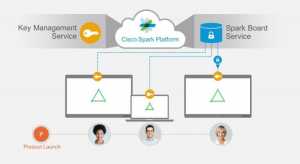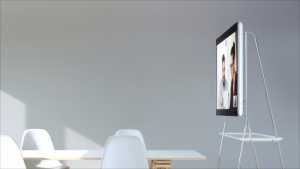Teleconferencing has been both a boon and a bane for businesses for many years. There are not many among us who haven’t struggled with cranky video systems, desktop conference phones whose operation needs an engineering degree, and dial-up that doesn’t. It’s been estimated that we waste a good ten minutes of every conferenced meeting just trying to connect.
Yet it’s a technology that’s becoming more and more necessary in our tumultuous world, as companies expand to multiple locations, often in several countries. Teams are spread across locations, yet still must collaborate. Sometimes they just need to talk, sometimes they need to share screens or to whiteboard, but always they need the technology to just work. They don’t have time to mess around with unusable systems. And vendors are throwing their hats into the ring, developing new systems that don’t require the great tangles of wire and collections of devices that used to plague conference rooms.
The most recent addition to this category is the Cisco Spark Board. An all-in-one video and audio conferencing system and digital whiteboard (no more snapping pictures or adding those oft-ignored “Do Not Erase” messages to the board to preserve content), the Spark Board dispenses with most wires and is powered by the cloud and the Cisco Spark platform, with a little help from technology from Cisco’s WebEx conferencing system. It competes with devices like the Microsoft Surface Hub and the Google Jamboard.

At a recent Spark Board launch event, Cisco VP Rowan Trollope illustrated the technology shift by dumping a wheelbarrow full of traditional videoconferencing equipment and cabling onto the stage. Beside that small mountain, he wheeled out the Spark Board that replaces it – a big screen television (currently 55 inch, with a 70 inch coming later this year), with only a single power cable.
Of course, that TV has a few tricks up its electronic sleeve. Concealed in the bezel there’s a 4K, 60 frame per second, wide angle camera and a 12 element microphone array that zooms in on the speaker to make sure he or she can be clearly heard. The display is a touchscreen, and there’s a digital pen that’s designed to look and feel like a dry erase marker sitting in a niche below the screen. Every whiteboard needs a dry erase marker.
Other than the pen, there are no I/O devices needed. There’s no remote to lose, and actually there are no visible physical controls aside from the equivalent of a Home button in the middle of the bottom bezel. The Spark Board is, operationally, the equivalent of a giant tablet computer.
The difference is, you can interact with it using your personal device. But you don’t have to deliberately pair to it – it doesn’t use Bluetooth to connect, it uses ultrasound, which Cisco chose because, unlike Bluetooth, it can be constrained by the walls of a room, preventing outside snooping. All you need is a device running the Cisco Spark collaboration software. Walk into the room, and you’re automagically signed in. Leave the room, and you’re signed out. No more walking away leaving your account exposed because you forgot to log off the conference system.
Participants can interact with the meeting from phones, computers, or tablets, via Cisco Spark. Or, they can work on the Spark Board if they’re onsite, and the entire meeting’s interactions are saved in the cloud, in a virtual room, for later reference. And by “interact,” I mean talk to each other, share presentations and documents, co-edit documents, scribble on the whiteboard, and edit each other’s scribbles. Everyone with access to the Spark room can continue to work on the meeting materials after the session.
 Because security is top-of-mind for most enterprises, Cisco offers end-to-end encryption. Data is encrypted on the device – PC, tablet, phone, or Spark Board – before transmission to the cloud, and remains encrypted in motion and at rest. Currently, the key servers also live in the cloud, but within the next few months, on-premises key servers will also be available, an addition driven by customer demand.
Because security is top-of-mind for most enterprises, Cisco offers end-to-end encryption. Data is encrypted on the device – PC, tablet, phone, or Spark Board – before transmission to the cloud, and remains encrypted in motion and at rest. Currently, the key servers also live in the cloud, but within the next few months, on-premises key servers will also be available, an addition driven by customer demand.
Cisco’s Apple partnership has created close integration with iOS, to the point that simply tapping a call on an iPhone will initiate a meeting on the Spark Board.
Simplicity was one of the design goals for both the Spark Platform and Spark Board. CTO Jonathan Rosenberg said that after the team wrote down meeting pain points, it had an ‘aha’ moment, realizing that it had been thinking about meetings all wrong. Initially, the team separated interactions into four categories: scheduled meetings, ad hoc meetings, furious chat, and occasional messaging. Then the group realized that the categories were not discrete, instead, they flow into each other. A casual chat grows into a more intense discussion, which in turn can become an ad hoc meeting as participants flesh out their ideas. Then they may decide to schedule a more formal meeting. Yet, he noted, meeting tools aren’t continuous – you have to launch separate applications for each type of meeting.
A nyone who’s worked in a distributed team would agree. I can recall sitting on IP conference calls in WebEx listening to vendors present, while using a separate chat application for side discussions with colleagues to agree on questions to ask the vendor. Then we’d have to schedule another, separate meeting for the team to go over the pros and cons of that vendor’s proposal. We’d mix and match conferencing and email and chat software, hopping from one to the other as required. But then, of course, we had to keep referring to documentation and discussions in the other applications.
nyone who’s worked in a distributed team would agree. I can recall sitting on IP conference calls in WebEx listening to vendors present, while using a separate chat application for side discussions with colleagues to agree on questions to ask the vendor. Then we’d have to schedule another, separate meeting for the team to go over the pros and cons of that vendor’s proposal. We’d mix and match conferencing and email and chat software, hopping from one to the other as required. But then, of course, we had to keep referring to documentation and discussions in the other applications.
Spark, and the Spark Board, attempt to remedy the situation. Spark rooms contain all of the content, from documents and whiteboard contents to chat history, involved in a project, and the product was designed to accommodate and launch everything from a phone call or video conference to a chat session from within its interface. Its API lets organizations hook it into their processes, and it already contains integrations to popular products and services like Twitter, Box, Dropbox, OneDrive, and GitHub. Users can opt to receive alerts about new content, and reminders about meetings and tasks.
The current iteration of the Spark software adds a much-needed search function – one issue with the original version was that, as rooms grew, it was difficult to find anything. Since content is displayed sequentially, rather like an Internet discussion forum, there can be a lot of scrolling involved.
The learning curve for the Spark Board is pretty flat – it and the Spark client software share a similar user interface. Users should be equally comfortable in a meeting room playing on the Spark Board, or at their desks with phone, tablet, or computer.
Since for distributed teams, electronic meetings are a fact of life, technologies like the Spark Board and Spark software are becoming a necessity. With Spark Board, telepresence and digital whiteboarding can be used without the addition of servers and special environments. Everything is in the cloud.
The 55 inch Spark Board is priced at $6,586 (all prices Canadian) and the 70 inch will cost $13,186 when it is released later this year. It also requires a $262 per month software subscription ($223 per month if prepaid for three years), which also covers updates and support.








